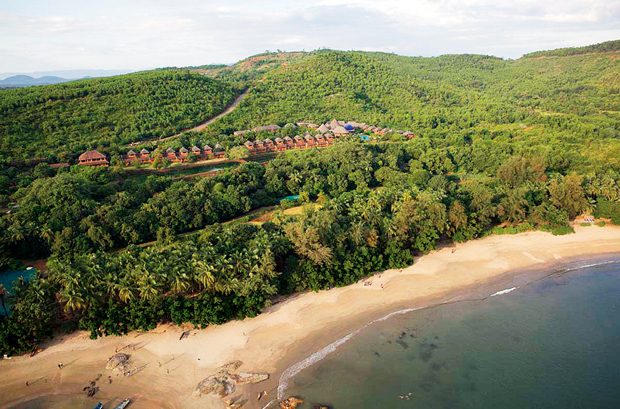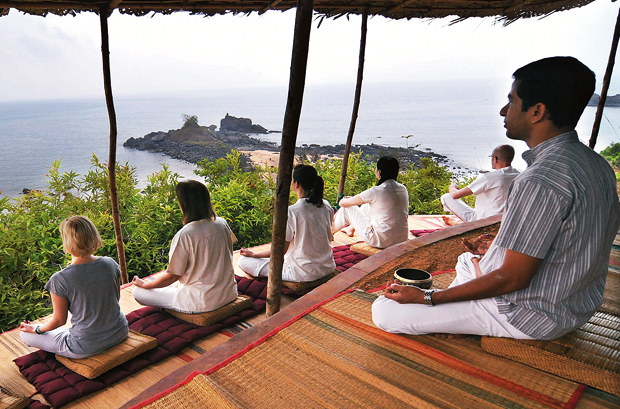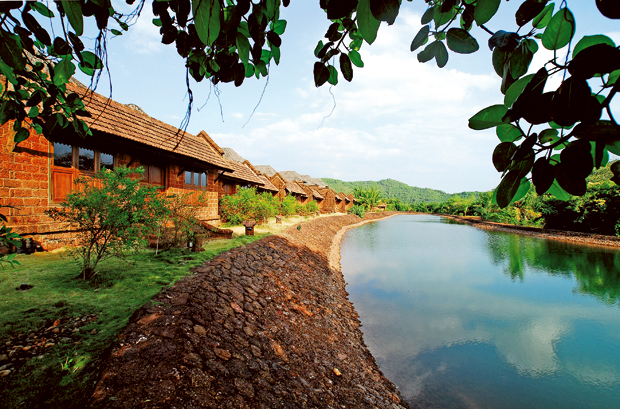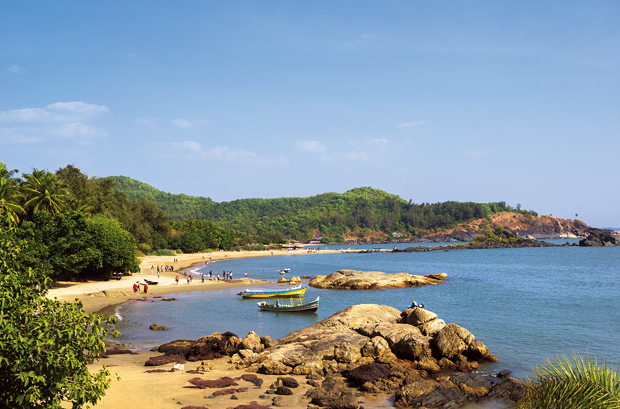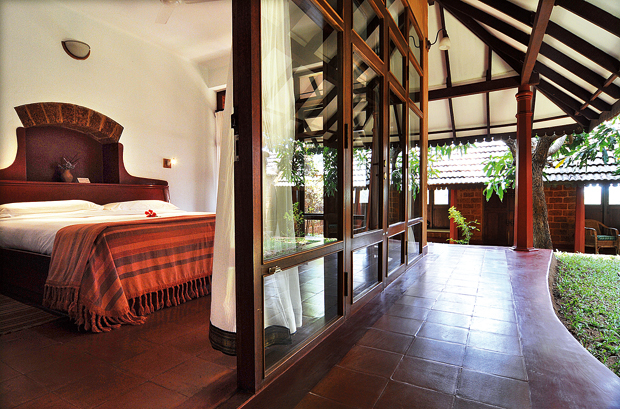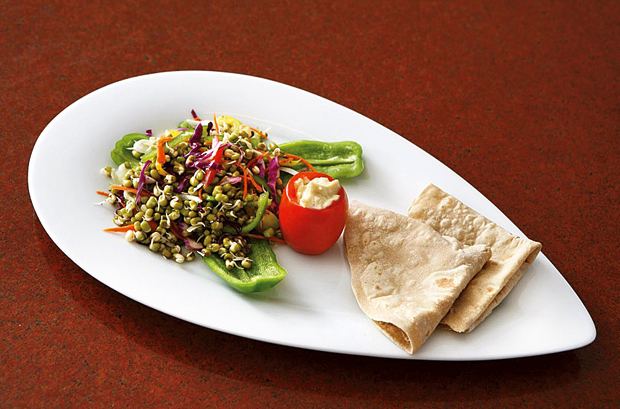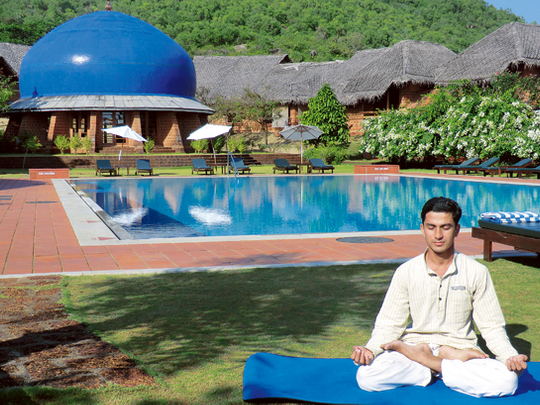
You must be joking,’’ said my 14-year-old daughter when she heard I was off to spend a few days at SwaSwara, a yoga and wellness sanctuary in southern India.
“You, who can’t be away from Facebook or Twitter for even a few minutes, are going to a place where there’s no Wi-Fi in the rooms, no TV, no music… well I’m glad I’m not coming!” she proclaimed, before turning her attention back to her iPad.
“I couldn’t take you even if you wanted to come along,’’ I replied. “They have a strict child policy – no children under 15.’’
But she wasn’t even listening.
Initially I was faced with a dilemma when I was offered the opportunity to visit SwaSwara in Gokarna, Karnataka. No doubt, the pictures and the info posted on its website were an instant draw.
Set in a verdant forest, which overlooks a spectacular beach and is fringed by peaks begging to be climbed, not to mention a quaint, historically and culturally rich village just a few kilometres away, it offers the ideal setting for de-stressing. Included were unlimited yoga and meditation sessions and plenty of rejuvenating Ayurvedic massages and therapies. So what was there to think about?
For one, I am a strict non-vegetarian, to the point I eat veggies under duress, and the only non-veg meals at SwaSwara are occasional seafood dishes. Would I survive three nights without a chicken biryani or mutton kebabs? Probably, but it wouldn’t be fun.
Also, I admit my daughter had a point. I am ever so slightly addicted to social media. So with no TV, newspapers or Wi-Fi in the villas, I would be at a complete loss.
Even as I was debating whether to go, an email from my editor arrived: “SwaSwara is confirmed. Am sure you will enjoy the time there fine-tuning your yoga postures.’’
It was settled. I went home and began packing my bag, and this time it was my wife who was to question my plans. “What is SwaSwara all about?’’ she asked, checking to see if I knew what I was getting into.
“Well, SwaSwara means an introduction to a life plan that will reconstruct the mind and body, creating balance and harmony within,’’ I said, sneaking a peek at my phone, which was logged on to the website. “The word also means ‘a place where you get to listen to your inner voice’.’’
“You don’t even listen to me and you are going to listen to your inner voice?’’ she asked. I let that pass. “They offer guests a holistic plan to detoxify, refresh, rejuvenate and be in tune with nature,’’ I said.
“Well, I do think you need to detoxify; and if rejuvenation means not lying on the sofa all weekend, I’ll pay for the ticket,’’ she said. “Got your travel plans?” I grinned. “I’ll be flying in to Goa, and then driving to Gokarna,’’ I said.
The look in her eyes was clear: she did not believe I would be leaving Goa. After all, few people go anywhere else once they land in that spectacular tourist magnet.
“I’ll drive up to Gokarna from Goa,” I repeated, which was met with a knowing smile.
The best way to get to Gokarna from Dubai really is to fly into Goa. But beware – the breathtaking beaches, laid-back ambience, mouth-watering cuisine and the sumptuous seafood in this little west Indian state could tempt anyone to stay put. Luckily there was a driver waiting at arrivals to whisk me off to SwaSwara wellness sanctuary.
Driving at 3am through the streets of what was once a Portuguese colony was a breeze, literally. The cool winds blowing in from Goa’s coast were invigorating and scant traffic meant we made the 140km-odd trek to Gokarna in a little under three hours.
The route was spectacularly picturesque – cutting through thick mist-enveloped forests and winding up a mountain, I watched as a picture perfect sun began to slowly rise majestically from behind the imposing mountains.
It was around 7am when we turned a sharp corner to face a set of gates being thrown open for us to enter. The first thing that caught my eye was the conical thatched roof of the lobby.
Built in an architectural style typical of the rural area – uncemented walls, tiled roofs for the villas, earthy tone interiors, large windows, airy rooms – the wellness sanctuary appeared to blend into the surroundings. Mini Chandran, general manager of Swaswara, was there to welcome me.
Walking through the sparse lobby, I noticed how quiet it was. Except for the tinkling of a wind chime in the distance and chirping of birds in the garden there was near silence. No plinky-plonk hotel lobby music here. No hustle and bustle of guests or service staff. Nothing. I found it strangely soothing.
Over a cup of tea Mini gave me an overview of the property and the philosophy of the resort: “The idea at SwaSwara is to live as one with nature, without disturbing the fine balance and while being in harmony with yourself and your surroundings,’’ she said. It sounded good but I was groggy with sleep after the late-night flight and long drive and was keen to rest before checking out all the sanctuary had to offer. So I headed off to my villa, one of 24 constructed in such a way as to blend in subtly with the sprawling forest around us.
My villa was fit for a king. Boasting two levels, it had a large bedroom, a quaint, open-to-the-skies bath, a lovely pantry area all set around a green indoor garden on the ground floor, while the first floor had a yoga studio, a balcony and a comfy alcove where guests can relax and do nothing but watch the birds and the butterflies flit around. In silence.
The rear of the pantry opens out into green woods and the rainwater catchment area, which doubles as a pond. “It’s great to spend the evening here – you can spot a lot of birds,’’ said Chinmay Pathak, who is in charge of the rooms. I had to agree, and for a moment I considered skipping the planned snooze and heading off into the woods.
“Would you like some lemon grass tea?” Chinmay asked. “Sure,’’ I said, and he promptly switched on the kettle, stepped into the garden and picked a couple of blades of lemon grass from the lawns, ran it under a tap, crushed it and added it to the boiling water. It tasted heavenly.
“I’ll go for some basil tea,’’ he said, stepping back out and plucking basil leaves from a bush. “You can’t get it fresher than that, can you?’’ he said, showing off the range of herbs growing in the garden.
I was impressed. Instinctively, I picked up my smartphone before Chinmay reminded me that Wi-Fi was not available in rooms – I couldn’t catch up with what was happening in the world, and the world wouldn’t know that I was in this spectacular place!
Handing me the key, Chinmay promised to give me a call in two hours and slipped out of the villa.
Forty winks later, I had a quick shower and set off to explore the area. Set in 26 acres of land, SwaSwara is perched on a hill that overlooks Om beach – a haven for backpackers. It’s a magnet for those wanting to de-stress and relax with Ayurvedic massages and healthy food.
“What you can expect to find at SwaSwara is an escape from the daily rigours of life. We offer all facilities to help you reconnect with your inner self,’’ said Mini.
And how do you do that?
“It’s really simple,’’ she said. “Meditation is one way. Then there are yoga sessions and Ayurvedic and naturopathic therapies, which help refresh and rejuvenate your body, improve blood circulation, calm stressed-out nerves and help you relax totally.’’
I decided to check out the Ayurvedic therapies first. “Namaste,’’ said a pleasant-faced Dr Shobha Dayanand, inviting me in for a consultation. After a barrage of questions about my lifestyle, health and diet, she booked me a rejuvenating therapy.
At the appointed time, I sneaked out of my villa dressed only in a bathrobe and made my way to the Ayurvedic massage room located about 50m away.
Two male masseurs were ready for me with a warm concoction of oils that smelt like all manner of spices and herbs, some of which I was sure I’d tasted in a biryani. But the massage was easily the best I’d ever had. By the end of the 45 minutes I was so relaxed I’d dozed off. The masseur had to awaken me to tell me my hot bath was ready after which, wrapped up in the bathrobe, I was given a cup of herbal tea.
The challenge before me now was choosing whether to catch the sunset on the sandy beach or head to the meditation room to find myself.
The outdoors won. I could always find myself later, I thought. Stretched out on the sands and watching the deep orange disc slip into the waters was as relaxing for my mind as the massage was for my body.
It was several hours later that I began making my way back to the sanctuary. I’d been smart enough to take along the torch that had been thoughtfully left on the bedside table in my villa and now it came in handy.
Shining my way through the thicket, to the sound of crickets chirping and the odd owl hooting, I was hoping I wouldn’t come across any slithering reptiles. Thankfully, I didn’t.
“We haven’t spotted any poisonous snakes here,’’ said Chinmay who was in the reception, “though it always helps to be careful while walking outdoors at night.’’
Heading to the restaurant, I was puzzled to see that there was no menu as such. “The meals are fixed,’’ said chef Joy, coming around to my table for a chat. “I keep in mind the health needs of the guests here and create just two options – one veg and the other non-veg.
“At SwaSwara, we believe that it’s not just what you eat, it’s how you eat. We tend to rush though our meals, forgetting to taste the flavours and feel the textures. Take time to reconnect with the joy of eating and you will enjoy your food better.”
Of course I opted for non-veg – the Ajwain fish (sea bream marinated with carom seeds and baked in a clay oven) served with ghee paranthas. It was just delicious. I realised that not having too many choices was actually a good thing. I could use the time I would have spent choosing a dish to find myself.
After a lovely dessert aptly called Coconut dream – semolina cooked in sweetened coconut milk and delicately flavoured with saffron – I headed off to my villa.
“There’s Wi-Fi in the library,” said Mini helpfully, and I immediately fetched my smartphone. But surprise, surprise, nothing much had happened anywhere in the outside world. “How’s Goa?” my wife WhatsApped, adding a winky face. “This is even better,” I replied.
On my must-do list for the second day was yoga in the morning, a painting session at noon, a period of meditation and a trip to the village of Gokarna.
It was a struggle to get out of my comfortable bed at 6am, but my mat was waiting for me in the yoga and meditation hall – a large circular structure with a domed roof.
A yoga teacher took us – a group of around seven – through the basics of stretching and loosening up before moving on to the more rigorous postures.
Forty minutes later, I slipped on my shoes and headed for my villa where, after a shower and breakfast, I walked over to the art gallery for my next session.
“Take off your shoes and sit on the floor,’’ said the art teacher, a 20-something woman named Shoba, spreading out a bunch of paints and brushes and crayons. “Now relax and meditate.” I closed my eyes and then wondered how one relaxed.
“Try to calm your mind,” she suggested. But the more I tried not to think of anything, the more a flood of thoughts came rushing in – of the shack I had spotted on the beach, the trek Chinmay had told me about, my return tickets, lunch, the pending features I had to work on, the sunrise...
“OK, now stop and paint the first image that comes to your mind,” she said. I chose the orange crayon and began work on my sunrise painting. At the end of the nearly hour-long session, I was pleased with my handiwork. OK, it was no Constable but, then again, I’m not an artist.
On my way to the reception, I met Jeanne. A 77-year-old woman from Paris who I was told by the staff visits SwaSwara regularly, she was sprightly and had an amazing zest for life. With a twinkle in her eyes, she told me how she had travelled all the way from Rajasthan to Karnataka.
“I stopped by at Delhi, Mumbai, Kerala and Tamil Nadu, before coming here,” she said. “I spend at least a month here every year. This place is just so amazingly calm and quiet. I cannot think of a holiday anywhere else.”
I had to agree. It was a place unlike any other I’d been to. I fished out my phone to post an FB update when I realised there was no Wi-Fi. “The fact that Wi-Fi isn’t available everywhere is actually a good thing,” said Jeanne. “Now at least people will talk to each other.” I had to agree and the conversation we had was scintillating and without any disturbing pings from messages and updates.
But there was one more thing to do – a visit to the village of Gokarna. Chinmay had arranged for auto-rickshaws and 15 of us headed off. Quaint and rural, it was a typical Indian village where hawkers were selling everything from spices, fruits and vegetables to snacks and handicrafts. There was a fair-like atmosphere in the village square and locals were getting their shopping done while kids stuffed their faces with fried snacks freshly made on makeshift stoves set up on the pavements.
Walking around, I chanced upon a small bookstore. I spent the next hour rummaging through the treasure trove of books, with gratifying results.
Although I hadn’t really found myself, I’d found some of the books I’d always wanted including two by Hunter S Thompson – Fear and Loathing in Las Vegas and Gonzo Papers – which I hadn’t been able to find, even in large stores.
Heading to the airport the next day, I looked back at the pretty resort and made up my mind: I would return to this place at least one more time. Three days was too short a period to connect with myself. Or to hear my inner voice.


